Consumer Behaviour Analysis: Nestle's Social Influences and Marketing
VerifiedAdded on 2023/06/14
|14
|2818
|191
Report
AI Summary
This report provides an analysis of consumer behavior in relation to Nestle, specifically focusing on the factors influencing consumer purchase decisions and the company's marketing mix for its Maggie product line. It explores the consumer purchase decision process, including problem identification, information search, evaluation of alternatives, purchase decision, and post-purchase behavior. The report also examines the impact of social influences such as culture and social class on consumer buying decisions, detailing how these factors affect perceptions and preferences towards products like Maggie noodles. Furthermore, it delves into Nestle's marketing mix, covering product strategies, pricing policies, promotional activities, and distribution channels, with recommendations for improvement such as including recipe books and enhancing direct retailer engagement. The analysis concludes that understanding these factors is critical for Nestle to effectively target consumers and sustain its market position. Desklib offers similar solved assignments and past papers for students.
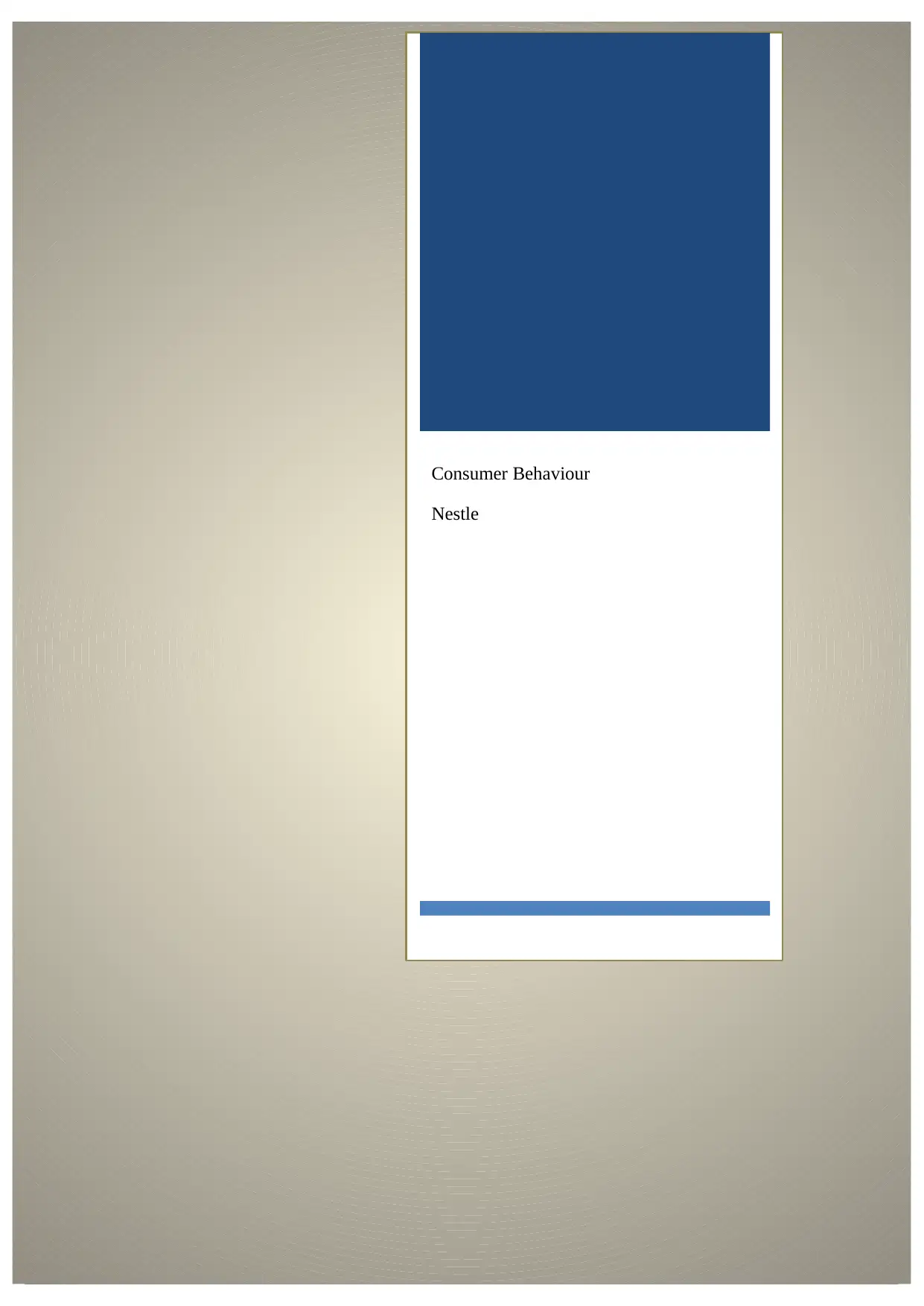
Consumer Behaviour
Nestle
Nestle
Paraphrase This Document
Need a fresh take? Get an instant paraphrase of this document with our AI Paraphraser
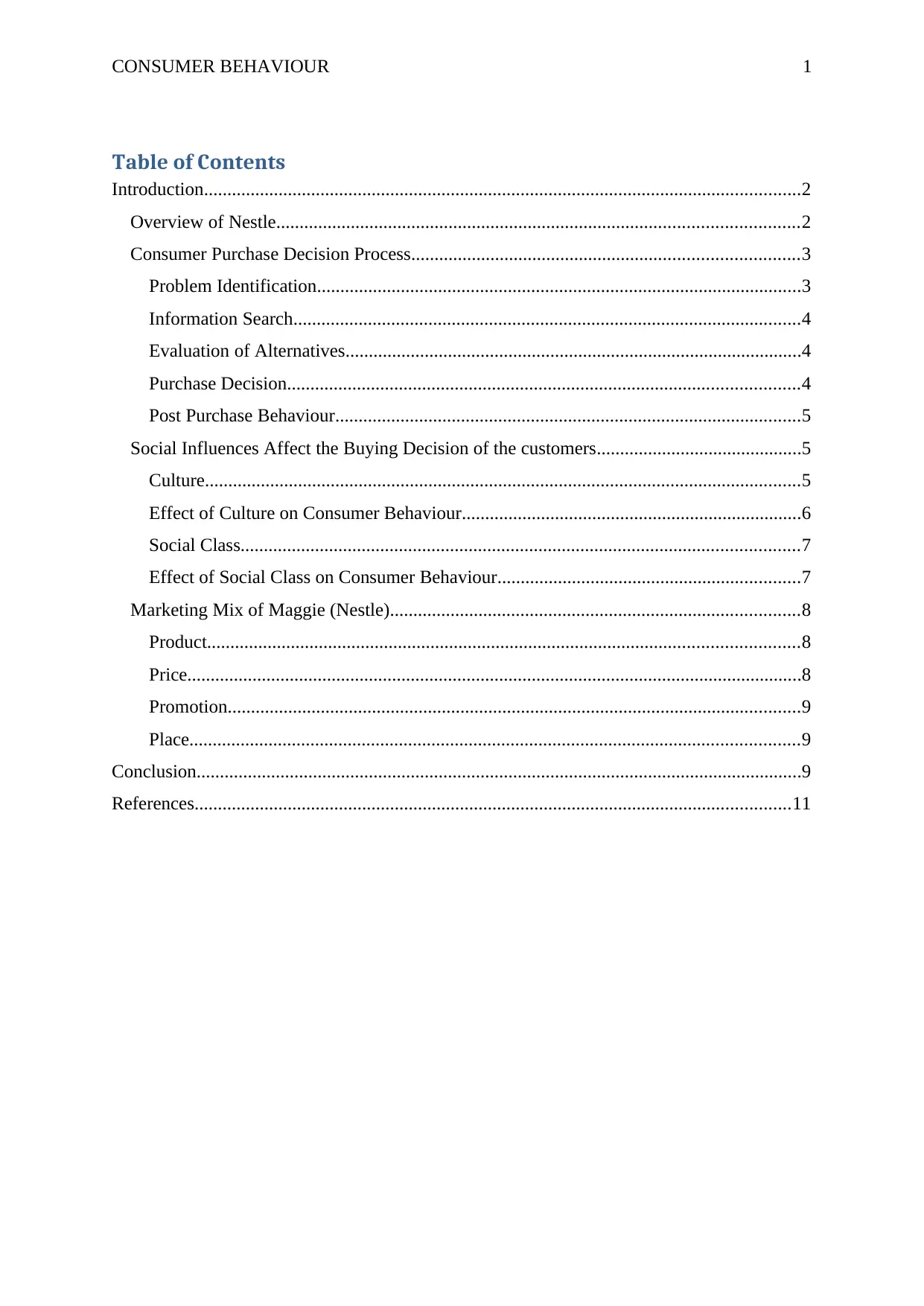
CONSUMER BEHAVIOUR 1
Table of Contents
Introduction................................................................................................................................2
Overview of Nestle................................................................................................................2
Consumer Purchase Decision Process...................................................................................3
Problem Identification........................................................................................................3
Information Search.............................................................................................................4
Evaluation of Alternatives..................................................................................................4
Purchase Decision..............................................................................................................4
Post Purchase Behaviour....................................................................................................5
Social Influences Affect the Buying Decision of the customers............................................5
Culture................................................................................................................................5
Effect of Culture on Consumer Behaviour.........................................................................6
Social Class........................................................................................................................7
Effect of Social Class on Consumer Behaviour.................................................................7
Marketing Mix of Maggie (Nestle)........................................................................................8
Product...............................................................................................................................8
Price....................................................................................................................................8
Promotion...........................................................................................................................9
Place...................................................................................................................................9
Conclusion..................................................................................................................................9
References................................................................................................................................11
Table of Contents
Introduction................................................................................................................................2
Overview of Nestle................................................................................................................2
Consumer Purchase Decision Process...................................................................................3
Problem Identification........................................................................................................3
Information Search.............................................................................................................4
Evaluation of Alternatives..................................................................................................4
Purchase Decision..............................................................................................................4
Post Purchase Behaviour....................................................................................................5
Social Influences Affect the Buying Decision of the customers............................................5
Culture................................................................................................................................5
Effect of Culture on Consumer Behaviour.........................................................................6
Social Class........................................................................................................................7
Effect of Social Class on Consumer Behaviour.................................................................7
Marketing Mix of Maggie (Nestle)........................................................................................8
Product...............................................................................................................................8
Price....................................................................................................................................8
Promotion...........................................................................................................................9
Place...................................................................................................................................9
Conclusion..................................................................................................................................9
References................................................................................................................................11
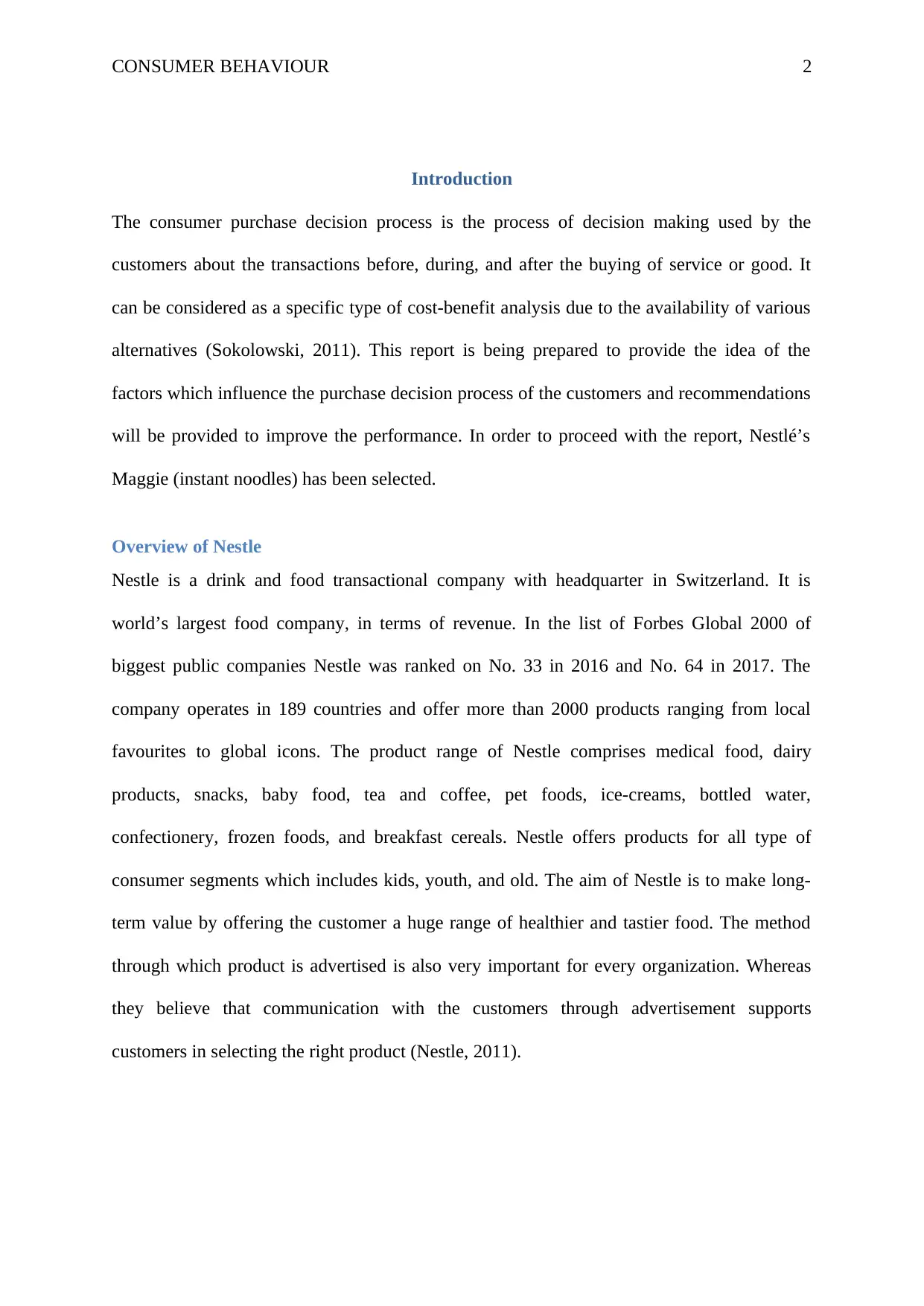
CONSUMER BEHAVIOUR 2
Introduction
The consumer purchase decision process is the process of decision making used by the
customers about the transactions before, during, and after the buying of service or good. It
can be considered as a specific type of cost-benefit analysis due to the availability of various
alternatives (Sokolowski, 2011). This report is being prepared to provide the idea of the
factors which influence the purchase decision process of the customers and recommendations
will be provided to improve the performance. In order to proceed with the report, Nestlé’s
Maggie (instant noodles) has been selected.
Overview of Nestle
Nestle is a drink and food transactional company with headquarter in Switzerland. It is
world’s largest food company, in terms of revenue. In the list of Forbes Global 2000 of
biggest public companies Nestle was ranked on No. 33 in 2016 and No. 64 in 2017. The
company operates in 189 countries and offer more than 2000 products ranging from local
favourites to global icons. The product range of Nestle comprises medical food, dairy
products, snacks, baby food, tea and coffee, pet foods, ice-creams, bottled water,
confectionery, frozen foods, and breakfast cereals. Nestle offers products for all type of
consumer segments which includes kids, youth, and old. The aim of Nestle is to make long-
term value by offering the customer a huge range of healthier and tastier food. The method
through which product is advertised is also very important for every organization. Whereas
they believe that communication with the customers through advertisement supports
customers in selecting the right product (Nestle, 2011).
Introduction
The consumer purchase decision process is the process of decision making used by the
customers about the transactions before, during, and after the buying of service or good. It
can be considered as a specific type of cost-benefit analysis due to the availability of various
alternatives (Sokolowski, 2011). This report is being prepared to provide the idea of the
factors which influence the purchase decision process of the customers and recommendations
will be provided to improve the performance. In order to proceed with the report, Nestlé’s
Maggie (instant noodles) has been selected.
Overview of Nestle
Nestle is a drink and food transactional company with headquarter in Switzerland. It is
world’s largest food company, in terms of revenue. In the list of Forbes Global 2000 of
biggest public companies Nestle was ranked on No. 33 in 2016 and No. 64 in 2017. The
company operates in 189 countries and offer more than 2000 products ranging from local
favourites to global icons. The product range of Nestle comprises medical food, dairy
products, snacks, baby food, tea and coffee, pet foods, ice-creams, bottled water,
confectionery, frozen foods, and breakfast cereals. Nestle offers products for all type of
consumer segments which includes kids, youth, and old. The aim of Nestle is to make long-
term value by offering the customer a huge range of healthier and tastier food. The method
through which product is advertised is also very important for every organization. Whereas
they believe that communication with the customers through advertisement supports
customers in selecting the right product (Nestle, 2011).
⊘ This is a preview!⊘
Do you want full access?
Subscribe today to unlock all pages.

Trusted by 1+ million students worldwide
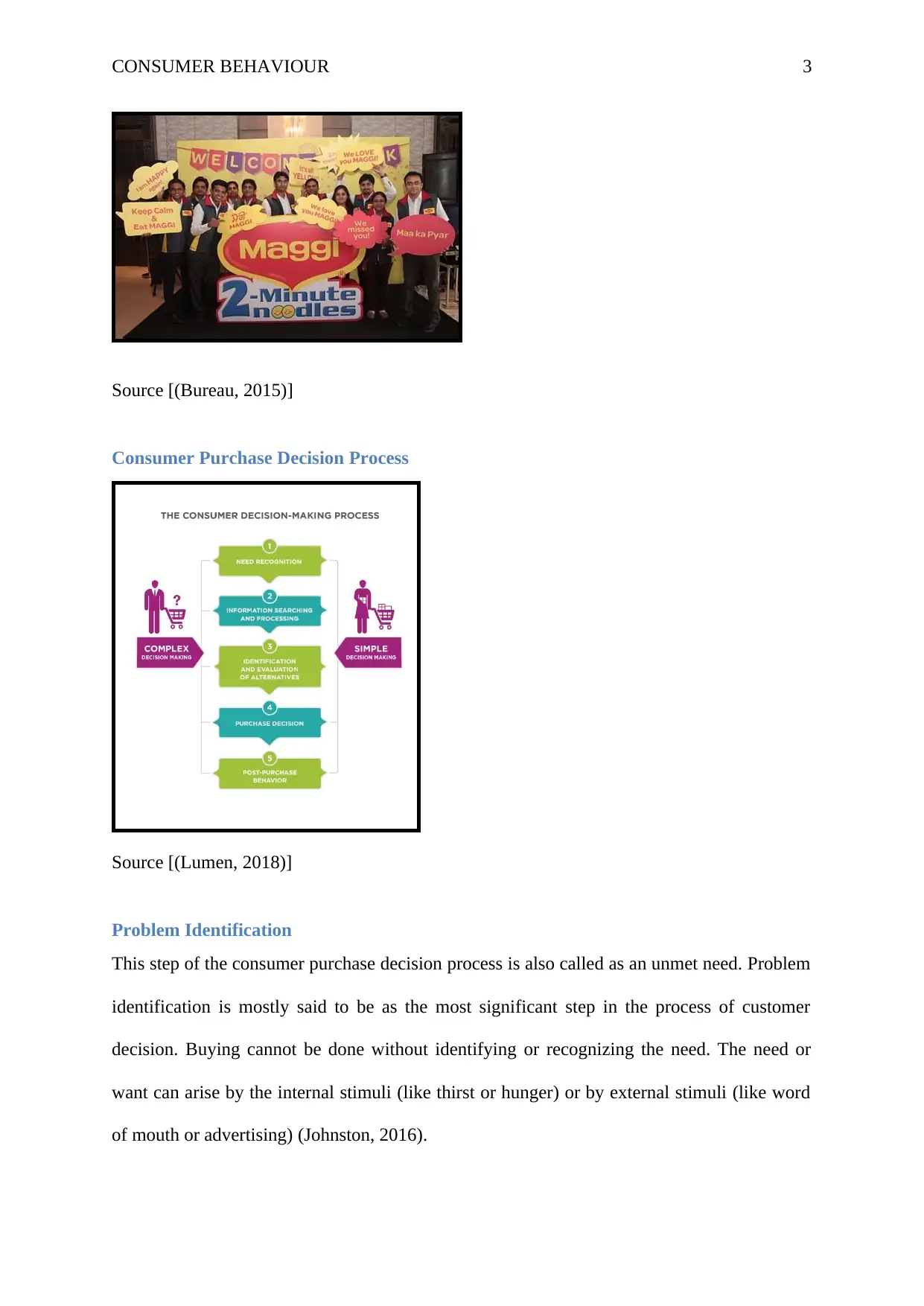
CONSUMER BEHAVIOUR 3
Source [(Bureau, 2015)]
Consumer Purchase Decision Process
Source [(Lumen, 2018)]
Problem Identification
This step of the consumer purchase decision process is also called as an unmet need. Problem
identification is mostly said to be as the most significant step in the process of customer
decision. Buying cannot be done without identifying or recognizing the need. The need or
want can arise by the internal stimuli (like thirst or hunger) or by external stimuli (like word
of mouth or advertising) (Johnston, 2016).
Source [(Bureau, 2015)]
Consumer Purchase Decision Process
Source [(Lumen, 2018)]
Problem Identification
This step of the consumer purchase decision process is also called as an unmet need. Problem
identification is mostly said to be as the most significant step in the process of customer
decision. Buying cannot be done without identifying or recognizing the need. The need or
want can arise by the internal stimuli (like thirst or hunger) or by external stimuli (like word
of mouth or advertising) (Johnston, 2016).
Paraphrase This Document
Need a fresh take? Get an instant paraphrase of this document with our AI Paraphraser
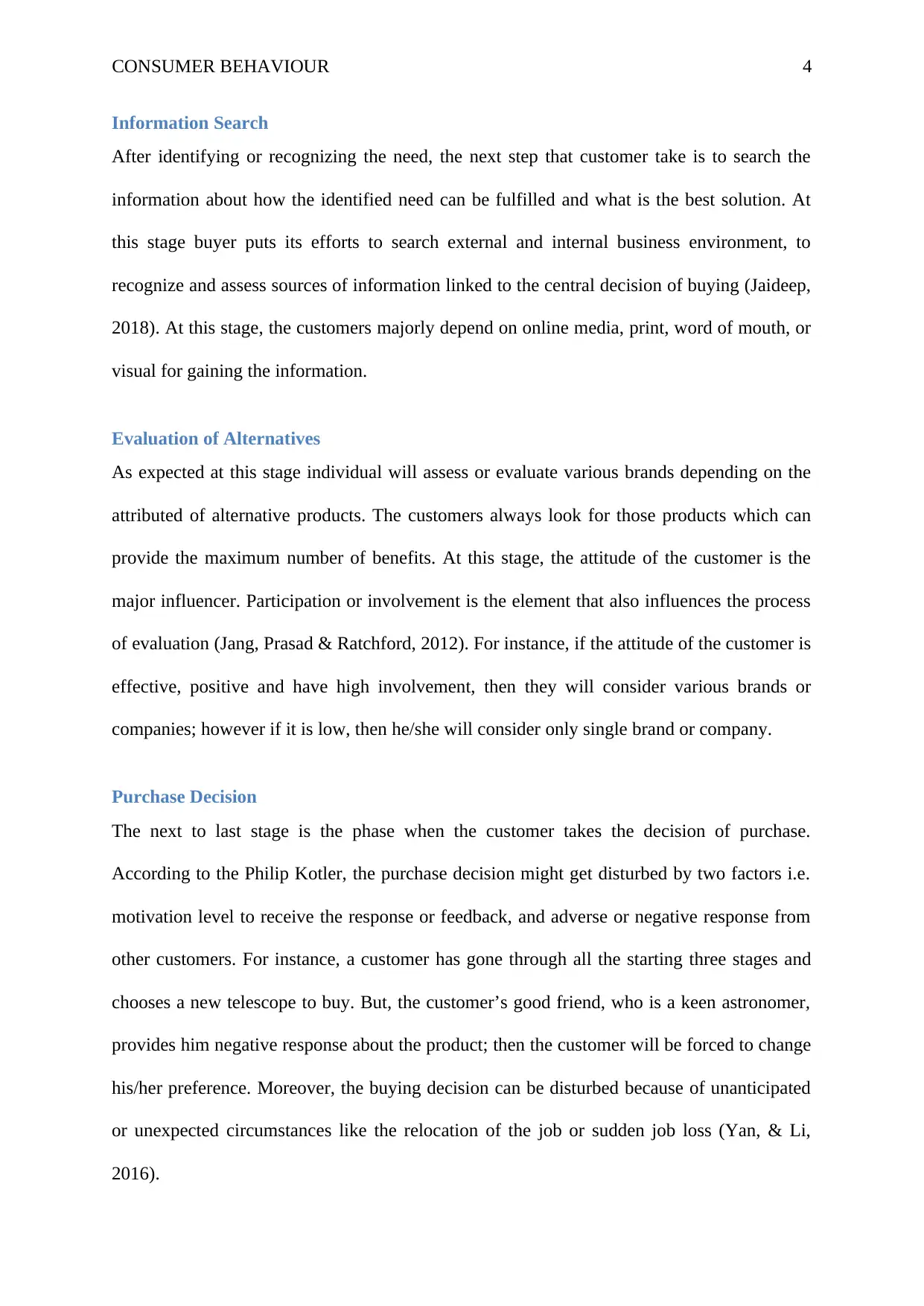
CONSUMER BEHAVIOUR 4
Information Search
After identifying or recognizing the need, the next step that customer take is to search the
information about how the identified need can be fulfilled and what is the best solution. At
this stage buyer puts its efforts to search external and internal business environment, to
recognize and assess sources of information linked to the central decision of buying (Jaideep,
2018). At this stage, the customers majorly depend on online media, print, word of mouth, or
visual for gaining the information.
Evaluation of Alternatives
As expected at this stage individual will assess or evaluate various brands depending on the
attributed of alternative products. The customers always look for those products which can
provide the maximum number of benefits. At this stage, the attitude of the customer is the
major influencer. Participation or involvement is the element that also influences the process
of evaluation (Jang, Prasad & Ratchford, 2012). For instance, if the attitude of the customer is
effective, positive and have high involvement, then they will consider various brands or
companies; however if it is low, then he/she will consider only single brand or company.
Purchase Decision
The next to last stage is the phase when the customer takes the decision of purchase.
According to the Philip Kotler, the purchase decision might get disturbed by two factors i.e.
motivation level to receive the response or feedback, and adverse or negative response from
other customers. For instance, a customer has gone through all the starting three stages and
chooses a new telescope to buy. But, the customer’s good friend, who is a keen astronomer,
provides him negative response about the product; then the customer will be forced to change
his/her preference. Moreover, the buying decision can be disturbed because of unanticipated
or unexpected circumstances like the relocation of the job or sudden job loss (Yan, & Li,
2016).
Information Search
After identifying or recognizing the need, the next step that customer take is to search the
information about how the identified need can be fulfilled and what is the best solution. At
this stage buyer puts its efforts to search external and internal business environment, to
recognize and assess sources of information linked to the central decision of buying (Jaideep,
2018). At this stage, the customers majorly depend on online media, print, word of mouth, or
visual for gaining the information.
Evaluation of Alternatives
As expected at this stage individual will assess or evaluate various brands depending on the
attributed of alternative products. The customers always look for those products which can
provide the maximum number of benefits. At this stage, the attitude of the customer is the
major influencer. Participation or involvement is the element that also influences the process
of evaluation (Jang, Prasad & Ratchford, 2012). For instance, if the attitude of the customer is
effective, positive and have high involvement, then they will consider various brands or
companies; however if it is low, then he/she will consider only single brand or company.
Purchase Decision
The next to last stage is the phase when the customer takes the decision of purchase.
According to the Philip Kotler, the purchase decision might get disturbed by two factors i.e.
motivation level to receive the response or feedback, and adverse or negative response from
other customers. For instance, a customer has gone through all the starting three stages and
chooses a new telescope to buy. But, the customer’s good friend, who is a keen astronomer,
provides him negative response about the product; then the customer will be forced to change
his/her preference. Moreover, the buying decision can be disturbed because of unanticipated
or unexpected circumstances like the relocation of the job or sudden job loss (Yan, & Li,
2016).
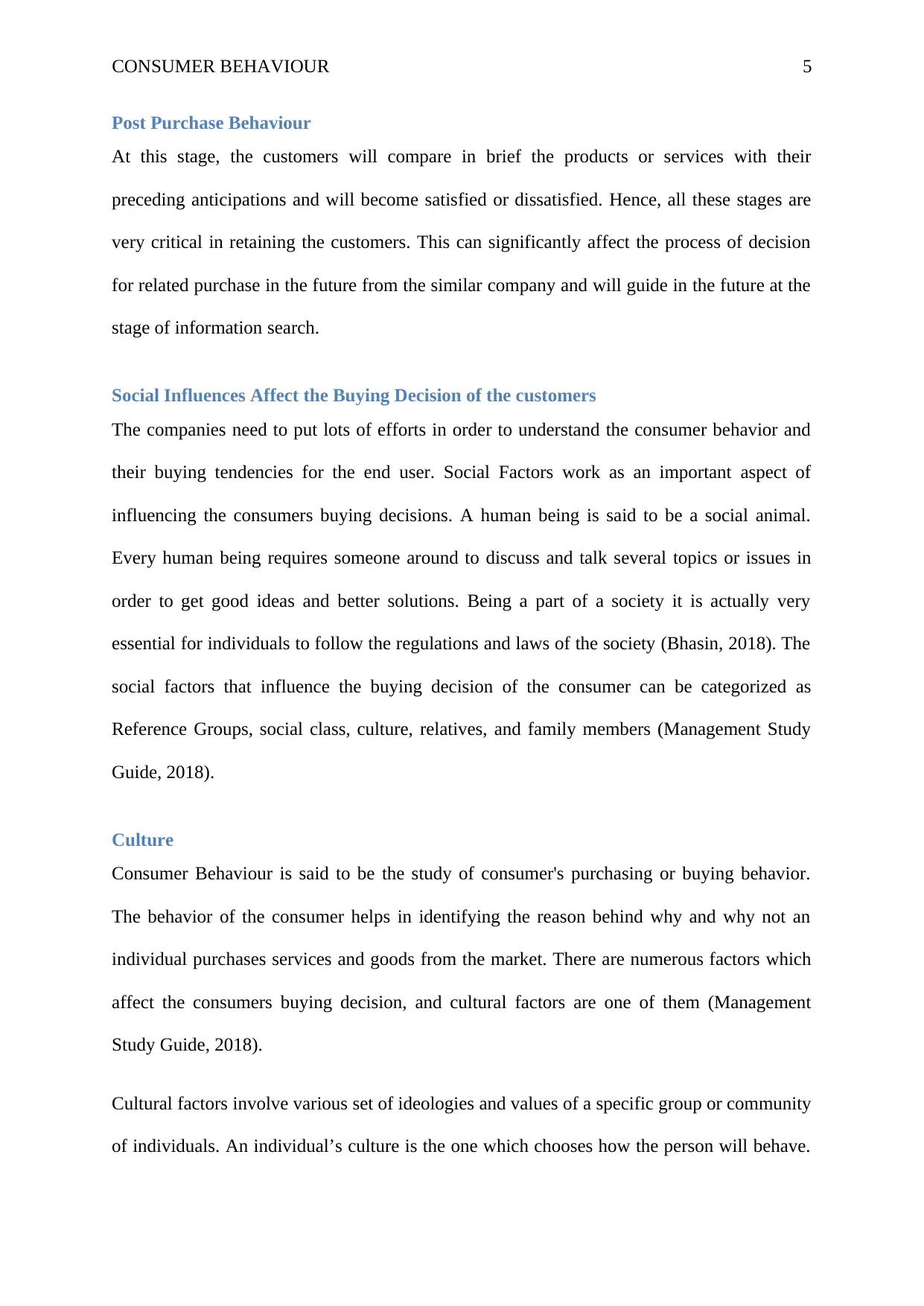
CONSUMER BEHAVIOUR 5
Post Purchase Behaviour
At this stage, the customers will compare in brief the products or services with their
preceding anticipations and will become satisfied or dissatisfied. Hence, all these stages are
very critical in retaining the customers. This can significantly affect the process of decision
for related purchase in the future from the similar company and will guide in the future at the
stage of information search.
Social Influences Affect the Buying Decision of the customers
The companies need to put lots of efforts in order to understand the consumer behavior and
their buying tendencies for the end user. Social Factors work as an important aspect of
influencing the consumers buying decisions. A human being is said to be a social animal.
Every human being requires someone around to discuss and talk several topics or issues in
order to get good ideas and better solutions. Being a part of a society it is actually very
essential for individuals to follow the regulations and laws of the society (Bhasin, 2018). The
social factors that influence the buying decision of the consumer can be categorized as
Reference Groups, social class, culture, relatives, and family members (Management Study
Guide, 2018).
Culture
Consumer Behaviour is said to be the study of consumer's purchasing or buying behavior.
The behavior of the consumer helps in identifying the reason behind why and why not an
individual purchases services and goods from the market. There are numerous factors which
affect the consumers buying decision, and cultural factors are one of them (Management
Study Guide, 2018).
Cultural factors involve various set of ideologies and values of a specific group or community
of individuals. An individual’s culture is the one which chooses how the person will behave.
Post Purchase Behaviour
At this stage, the customers will compare in brief the products or services with their
preceding anticipations and will become satisfied or dissatisfied. Hence, all these stages are
very critical in retaining the customers. This can significantly affect the process of decision
for related purchase in the future from the similar company and will guide in the future at the
stage of information search.
Social Influences Affect the Buying Decision of the customers
The companies need to put lots of efforts in order to understand the consumer behavior and
their buying tendencies for the end user. Social Factors work as an important aspect of
influencing the consumers buying decisions. A human being is said to be a social animal.
Every human being requires someone around to discuss and talk several topics or issues in
order to get good ideas and better solutions. Being a part of a society it is actually very
essential for individuals to follow the regulations and laws of the society (Bhasin, 2018). The
social factors that influence the buying decision of the consumer can be categorized as
Reference Groups, social class, culture, relatives, and family members (Management Study
Guide, 2018).
Culture
Consumer Behaviour is said to be the study of consumer's purchasing or buying behavior.
The behavior of the consumer helps in identifying the reason behind why and why not an
individual purchases services and goods from the market. There are numerous factors which
affect the consumers buying decision, and cultural factors are one of them (Management
Study Guide, 2018).
Cultural factors involve various set of ideologies and values of a specific group or community
of individuals. An individual’s culture is the one which chooses how the person will behave.
⊘ This is a preview!⊘
Do you want full access?
Subscribe today to unlock all pages.

Trusted by 1+ million students worldwide
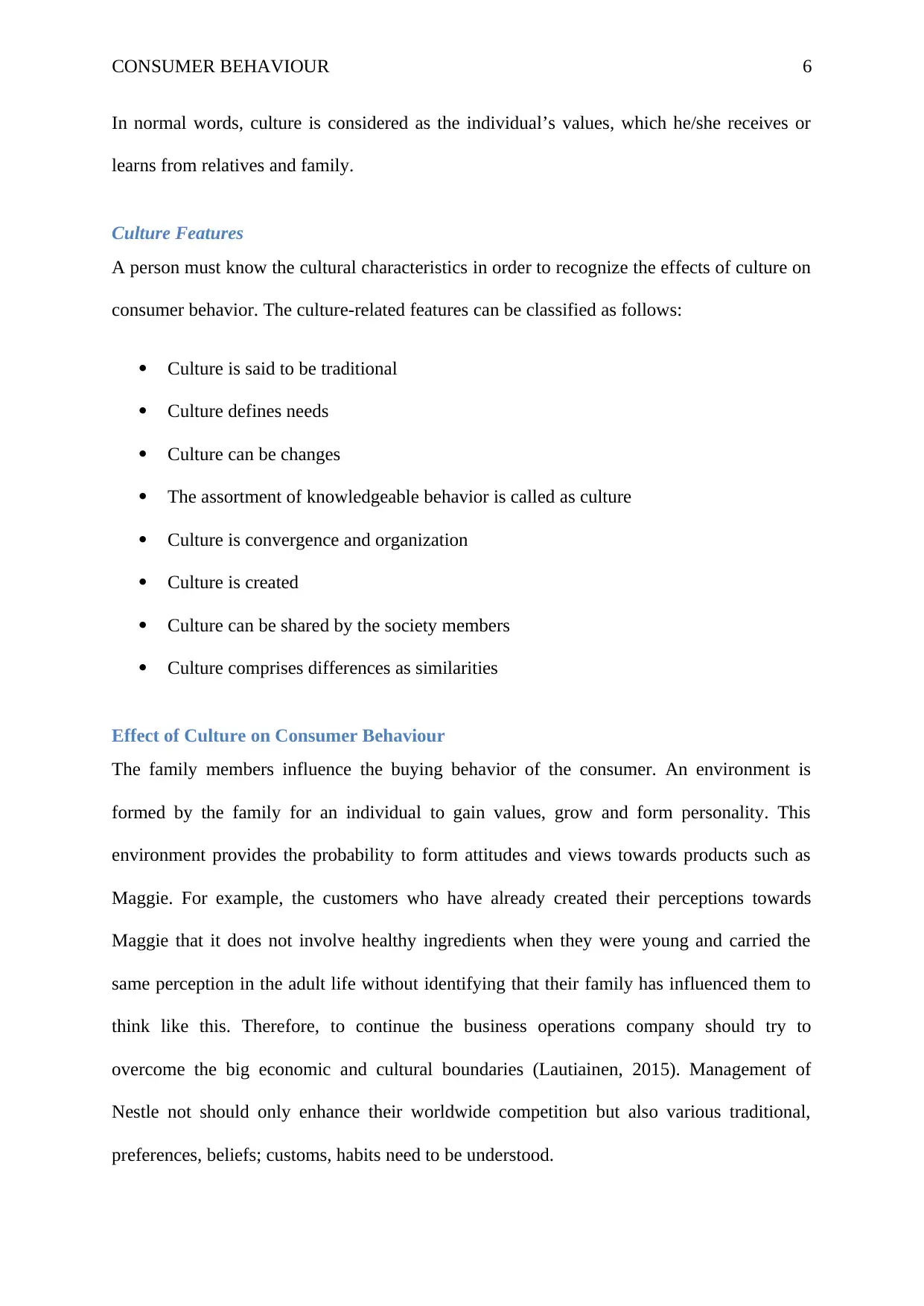
CONSUMER BEHAVIOUR 6
In normal words, culture is considered as the individual’s values, which he/she receives or
learns from relatives and family.
Culture Features
A person must know the cultural characteristics in order to recognize the effects of culture on
consumer behavior. The culture-related features can be classified as follows:
Culture is said to be traditional
Culture defines needs
Culture can be changes
The assortment of knowledgeable behavior is called as culture
Culture is convergence and organization
Culture is created
Culture can be shared by the society members
Culture comprises differences as similarities
Effect of Culture on Consumer Behaviour
The family members influence the buying behavior of the consumer. An environment is
formed by the family for an individual to gain values, grow and form personality. This
environment provides the probability to form attitudes and views towards products such as
Maggie. For example, the customers who have already created their perceptions towards
Maggie that it does not involve healthy ingredients when they were young and carried the
same perception in the adult life without identifying that their family has influenced them to
think like this. Therefore, to continue the business operations company should try to
overcome the big economic and cultural boundaries (Lautiainen, 2015). Management of
Nestle not should only enhance their worldwide competition but also various traditional,
preferences, beliefs; customs, habits need to be understood.
In normal words, culture is considered as the individual’s values, which he/she receives or
learns from relatives and family.
Culture Features
A person must know the cultural characteristics in order to recognize the effects of culture on
consumer behavior. The culture-related features can be classified as follows:
Culture is said to be traditional
Culture defines needs
Culture can be changes
The assortment of knowledgeable behavior is called as culture
Culture is convergence and organization
Culture is created
Culture can be shared by the society members
Culture comprises differences as similarities
Effect of Culture on Consumer Behaviour
The family members influence the buying behavior of the consumer. An environment is
formed by the family for an individual to gain values, grow and form personality. This
environment provides the probability to form attitudes and views towards products such as
Maggie. For example, the customers who have already created their perceptions towards
Maggie that it does not involve healthy ingredients when they were young and carried the
same perception in the adult life without identifying that their family has influenced them to
think like this. Therefore, to continue the business operations company should try to
overcome the big economic and cultural boundaries (Lautiainen, 2015). Management of
Nestle not should only enhance their worldwide competition but also various traditional,
preferences, beliefs; customs, habits need to be understood.
Paraphrase This Document
Need a fresh take? Get an instant paraphrase of this document with our AI Paraphraser
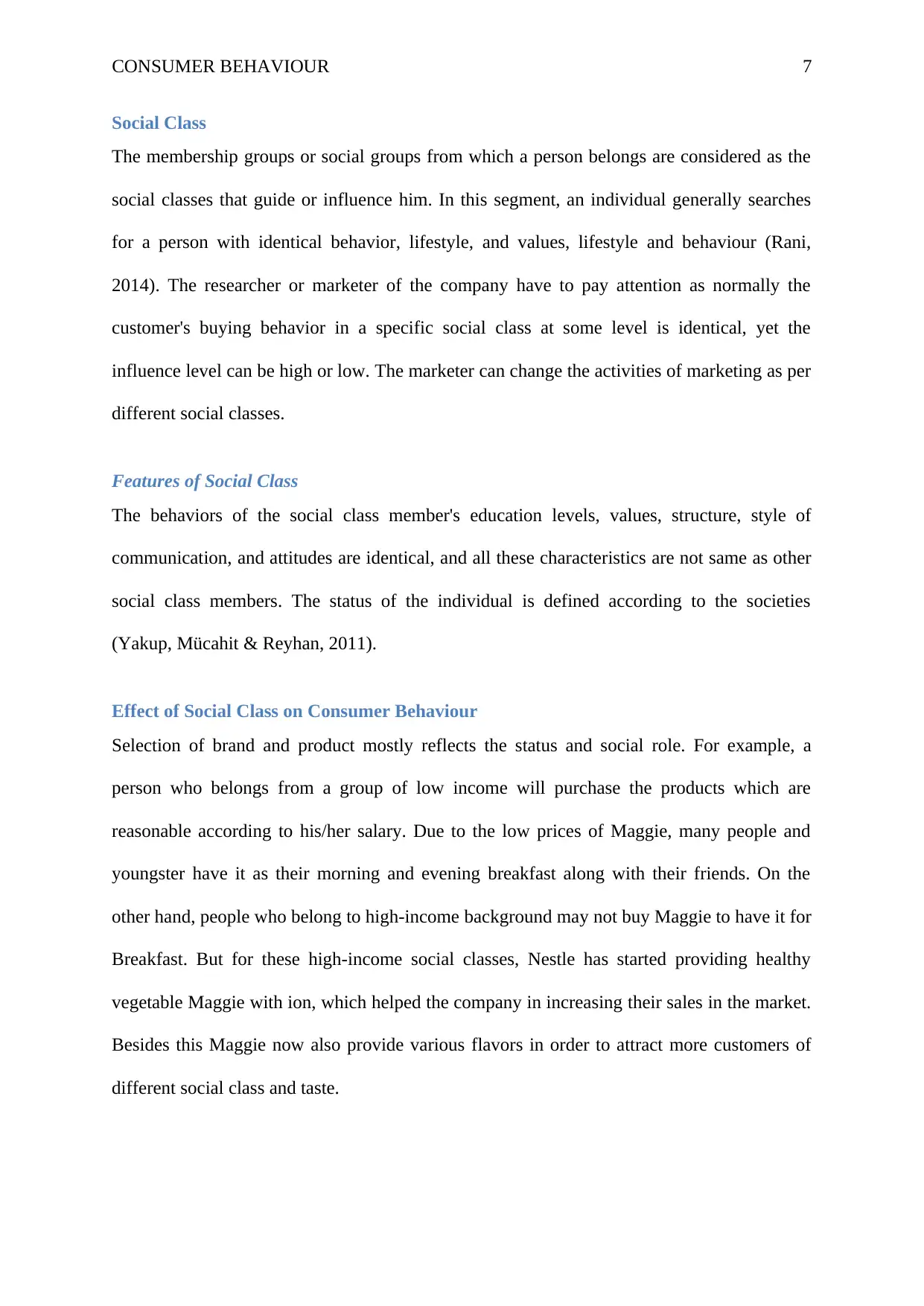
CONSUMER BEHAVIOUR 7
Social Class
The membership groups or social groups from which a person belongs are considered as the
social classes that guide or influence him. In this segment, an individual generally searches
for a person with identical behavior, lifestyle, and values, lifestyle and behaviour (Rani,
2014). The researcher or marketer of the company have to pay attention as normally the
customer's buying behavior in a specific social class at some level is identical, yet the
influence level can be high or low. The marketer can change the activities of marketing as per
different social classes.
Features of Social Class
The behaviors of the social class member's education levels, values, structure, style of
communication, and attitudes are identical, and all these characteristics are not same as other
social class members. The status of the individual is defined according to the societies
(Yakup, Mücahit & Reyhan, 2011).
Effect of Social Class on Consumer Behaviour
Selection of brand and product mostly reflects the status and social role. For example, a
person who belongs from a group of low income will purchase the products which are
reasonable according to his/her salary. Due to the low prices of Maggie, many people and
youngster have it as their morning and evening breakfast along with their friends. On the
other hand, people who belong to high-income background may not buy Maggie to have it for
Breakfast. But for these high-income social classes, Nestle has started providing healthy
vegetable Maggie with ion, which helped the company in increasing their sales in the market.
Besides this Maggie now also provide various flavors in order to attract more customers of
different social class and taste.
Social Class
The membership groups or social groups from which a person belongs are considered as the
social classes that guide or influence him. In this segment, an individual generally searches
for a person with identical behavior, lifestyle, and values, lifestyle and behaviour (Rani,
2014). The researcher or marketer of the company have to pay attention as normally the
customer's buying behavior in a specific social class at some level is identical, yet the
influence level can be high or low. The marketer can change the activities of marketing as per
different social classes.
Features of Social Class
The behaviors of the social class member's education levels, values, structure, style of
communication, and attitudes are identical, and all these characteristics are not same as other
social class members. The status of the individual is defined according to the societies
(Yakup, Mücahit & Reyhan, 2011).
Effect of Social Class on Consumer Behaviour
Selection of brand and product mostly reflects the status and social role. For example, a
person who belongs from a group of low income will purchase the products which are
reasonable according to his/her salary. Due to the low prices of Maggie, many people and
youngster have it as their morning and evening breakfast along with their friends. On the
other hand, people who belong to high-income background may not buy Maggie to have it for
Breakfast. But for these high-income social classes, Nestle has started providing healthy
vegetable Maggie with ion, which helped the company in increasing their sales in the market.
Besides this Maggie now also provide various flavors in order to attract more customers of
different social class and taste.
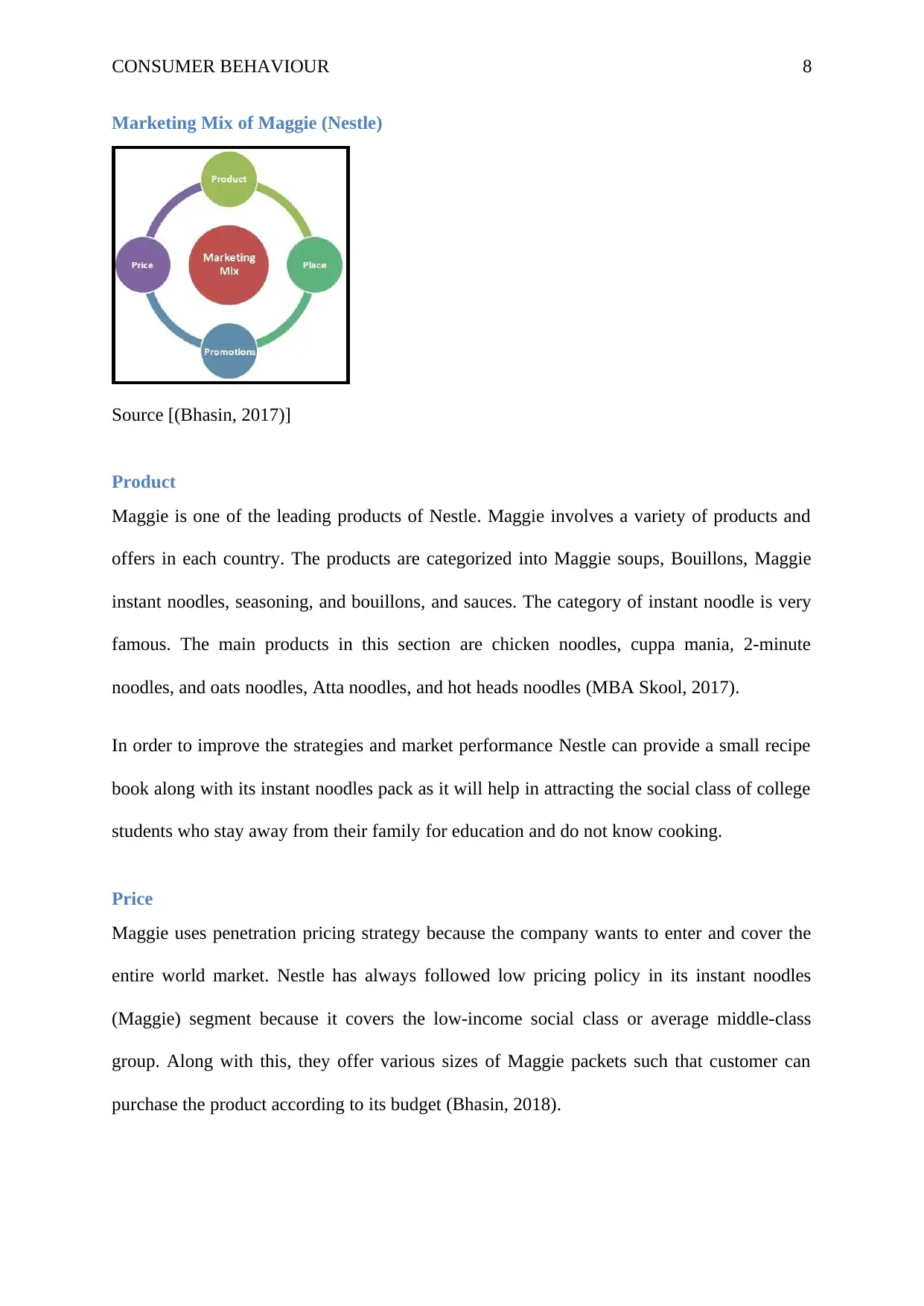
CONSUMER BEHAVIOUR 8
Marketing Mix of Maggie (Nestle)
Source [(Bhasin, 2017)]
Product
Maggie is one of the leading products of Nestle. Maggie involves a variety of products and
offers in each country. The products are categorized into Maggie soups, Bouillons, Maggie
instant noodles, seasoning, and bouillons, and sauces. The category of instant noodle is very
famous. The main products in this section are chicken noodles, cuppa mania, 2-minute
noodles, and oats noodles, Atta noodles, and hot heads noodles (MBA Skool, 2017).
In order to improve the strategies and market performance Nestle can provide a small recipe
book along with its instant noodles pack as it will help in attracting the social class of college
students who stay away from their family for education and do not know cooking.
Price
Maggie uses penetration pricing strategy because the company wants to enter and cover the
entire world market. Nestle has always followed low pricing policy in its instant noodles
(Maggie) segment because it covers the low-income social class or average middle-class
group. Along with this, they offer various sizes of Maggie packets such that customer can
purchase the product according to its budget (Bhasin, 2018).
Marketing Mix of Maggie (Nestle)
Source [(Bhasin, 2017)]
Product
Maggie is one of the leading products of Nestle. Maggie involves a variety of products and
offers in each country. The products are categorized into Maggie soups, Bouillons, Maggie
instant noodles, seasoning, and bouillons, and sauces. The category of instant noodle is very
famous. The main products in this section are chicken noodles, cuppa mania, 2-minute
noodles, and oats noodles, Atta noodles, and hot heads noodles (MBA Skool, 2017).
In order to improve the strategies and market performance Nestle can provide a small recipe
book along with its instant noodles pack as it will help in attracting the social class of college
students who stay away from their family for education and do not know cooking.
Price
Maggie uses penetration pricing strategy because the company wants to enter and cover the
entire world market. Nestle has always followed low pricing policy in its instant noodles
(Maggie) segment because it covers the low-income social class or average middle-class
group. Along with this, they offer various sizes of Maggie packets such that customer can
purchase the product according to its budget (Bhasin, 2018).
⊘ This is a preview!⊘
Do you want full access?
Subscribe today to unlock all pages.

Trusted by 1+ million students worldwide
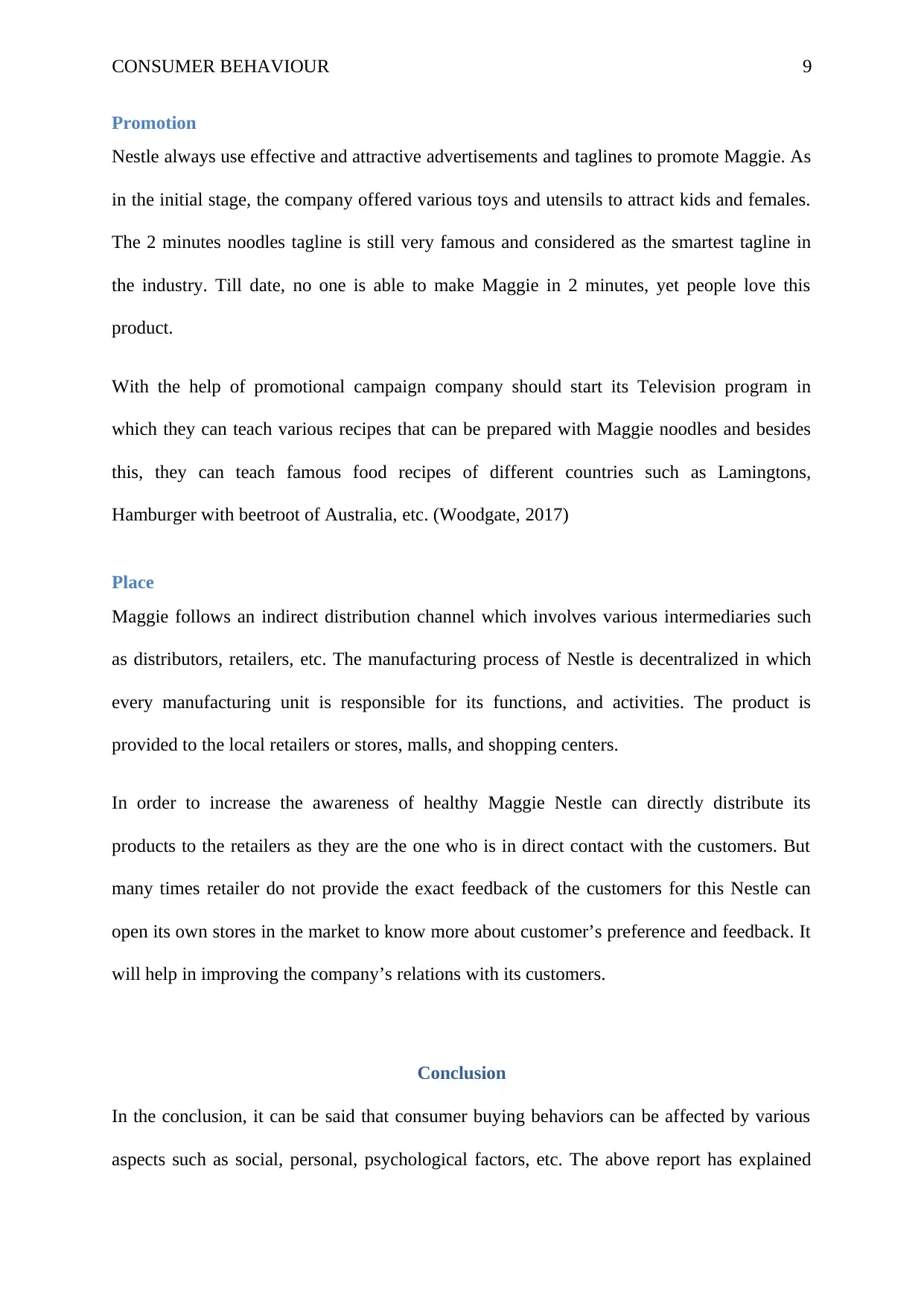
CONSUMER BEHAVIOUR 9
Promotion
Nestle always use effective and attractive advertisements and taglines to promote Maggie. As
in the initial stage, the company offered various toys and utensils to attract kids and females.
The 2 minutes noodles tagline is still very famous and considered as the smartest tagline in
the industry. Till date, no one is able to make Maggie in 2 minutes, yet people love this
product.
With the help of promotional campaign company should start its Television program in
which they can teach various recipes that can be prepared with Maggie noodles and besides
this, they can teach famous food recipes of different countries such as Lamingtons,
Hamburger with beetroot of Australia, etc. (Woodgate, 2017)
Place
Maggie follows an indirect distribution channel which involves various intermediaries such
as distributors, retailers, etc. The manufacturing process of Nestle is decentralized in which
every manufacturing unit is responsible for its functions, and activities. The product is
provided to the local retailers or stores, malls, and shopping centers.
In order to increase the awareness of healthy Maggie Nestle can directly distribute its
products to the retailers as they are the one who is in direct contact with the customers. But
many times retailer do not provide the exact feedback of the customers for this Nestle can
open its own stores in the market to know more about customer’s preference and feedback. It
will help in improving the company’s relations with its customers.
Conclusion
In the conclusion, it can be said that consumer buying behaviors can be affected by various
aspects such as social, personal, psychological factors, etc. The above report has explained
Promotion
Nestle always use effective and attractive advertisements and taglines to promote Maggie. As
in the initial stage, the company offered various toys and utensils to attract kids and females.
The 2 minutes noodles tagline is still very famous and considered as the smartest tagline in
the industry. Till date, no one is able to make Maggie in 2 minutes, yet people love this
product.
With the help of promotional campaign company should start its Television program in
which they can teach various recipes that can be prepared with Maggie noodles and besides
this, they can teach famous food recipes of different countries such as Lamingtons,
Hamburger with beetroot of Australia, etc. (Woodgate, 2017)
Place
Maggie follows an indirect distribution channel which involves various intermediaries such
as distributors, retailers, etc. The manufacturing process of Nestle is decentralized in which
every manufacturing unit is responsible for its functions, and activities. The product is
provided to the local retailers or stores, malls, and shopping centers.
In order to increase the awareness of healthy Maggie Nestle can directly distribute its
products to the retailers as they are the one who is in direct contact with the customers. But
many times retailer do not provide the exact feedback of the customers for this Nestle can
open its own stores in the market to know more about customer’s preference and feedback. It
will help in improving the company’s relations with its customers.
Conclusion
In the conclusion, it can be said that consumer buying behaviors can be affected by various
aspects such as social, personal, psychological factors, etc. The above report has explained
Paraphrase This Document
Need a fresh take? Get an instant paraphrase of this document with our AI Paraphraser
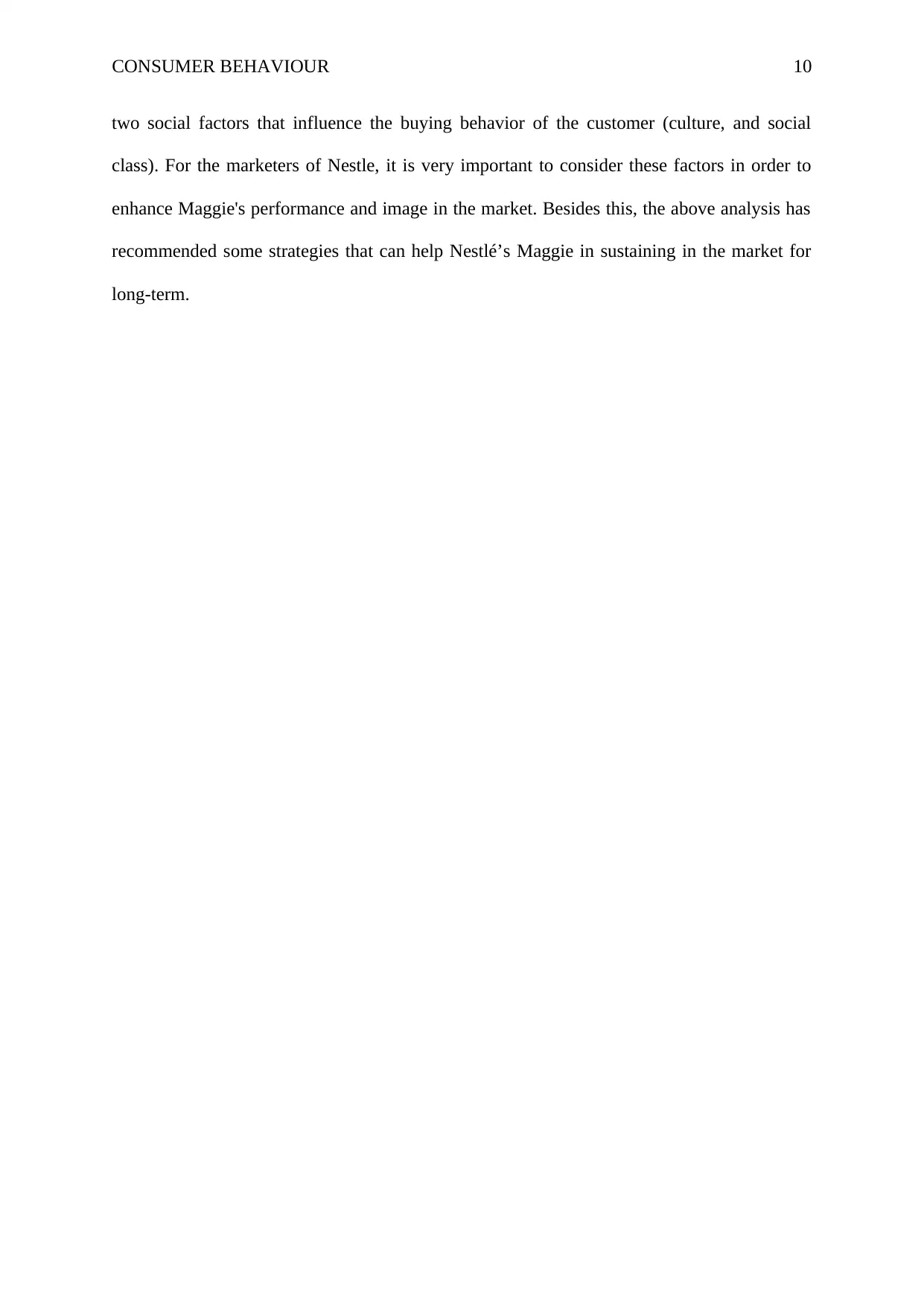
CONSUMER BEHAVIOUR 10
two social factors that influence the buying behavior of the customer (culture, and social
class). For the marketers of Nestle, it is very important to consider these factors in order to
enhance Maggie's performance and image in the market. Besides this, the above analysis has
recommended some strategies that can help Nestlé’s Maggie in sustaining in the market for
long-term.
two social factors that influence the buying behavior of the customer (culture, and social
class). For the marketers of Nestle, it is very important to consider these factors in order to
enhance Maggie's performance and image in the market. Besides this, the above analysis has
recommended some strategies that can help Nestlé’s Maggie in sustaining in the market for
long-term.
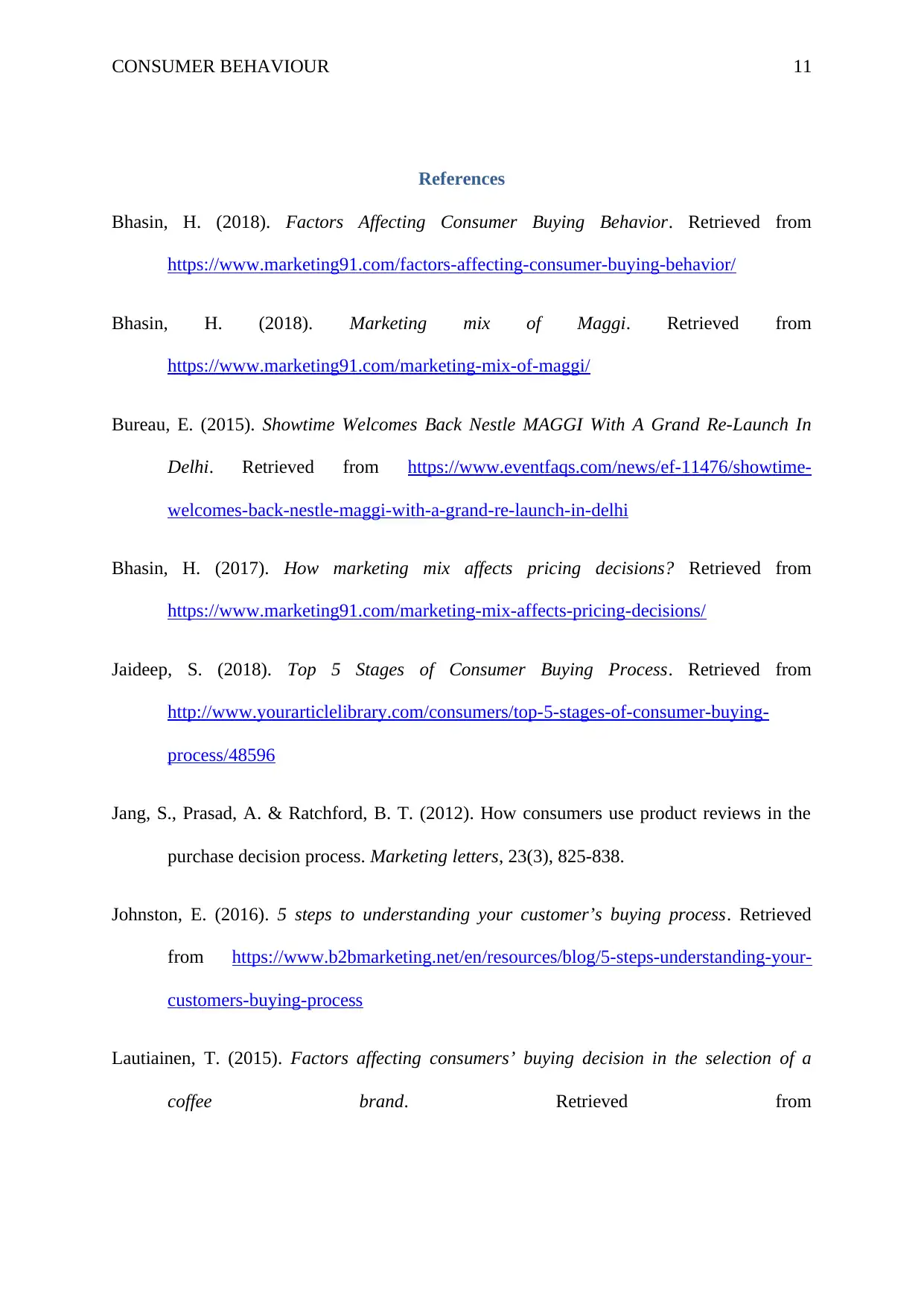
CONSUMER BEHAVIOUR 11
References
Bhasin, H. (2018). Factors Affecting Consumer Buying Behavior. Retrieved from
https://www.marketing91.com/factors-affecting-consumer-buying-behavior/
Bhasin, H. (2018). Marketing mix of Maggi. Retrieved from
https://www.marketing91.com/marketing-mix-of-maggi/
Bureau, E. (2015). Showtime Welcomes Back Nestle MAGGI With A Grand Re-Launch In
Delhi. Retrieved from https://www.eventfaqs.com/news/ef-11476/showtime-
welcomes-back-nestle-maggi-with-a-grand-re-launch-in-delhi
Bhasin, H. (2017). How marketing mix affects pricing decisions? Retrieved from
https://www.marketing91.com/marketing-mix-affects-pricing-decisions/
Jaideep, S. (2018). Top 5 Stages of Consumer Buying Process. Retrieved from
http://www.yourarticlelibrary.com/consumers/top-5-stages-of-consumer-buying-
process/48596
Jang, S., Prasad, A. & Ratchford, B. T. (2012). How consumers use product reviews in the
purchase decision process. Marketing letters, 23(3), 825-838.
Johnston, E. (2016). 5 steps to understanding your customer’s buying process. Retrieved
from https://www.b2bmarketing.net/en/resources/blog/5-steps-understanding-your-
customers-buying-process
Lautiainen, T. (2015). Factors affecting consumers’ buying decision in the selection of a
coffee brand. Retrieved from
References
Bhasin, H. (2018). Factors Affecting Consumer Buying Behavior. Retrieved from
https://www.marketing91.com/factors-affecting-consumer-buying-behavior/
Bhasin, H. (2018). Marketing mix of Maggi. Retrieved from
https://www.marketing91.com/marketing-mix-of-maggi/
Bureau, E. (2015). Showtime Welcomes Back Nestle MAGGI With A Grand Re-Launch In
Delhi. Retrieved from https://www.eventfaqs.com/news/ef-11476/showtime-
welcomes-back-nestle-maggi-with-a-grand-re-launch-in-delhi
Bhasin, H. (2017). How marketing mix affects pricing decisions? Retrieved from
https://www.marketing91.com/marketing-mix-affects-pricing-decisions/
Jaideep, S. (2018). Top 5 Stages of Consumer Buying Process. Retrieved from
http://www.yourarticlelibrary.com/consumers/top-5-stages-of-consumer-buying-
process/48596
Jang, S., Prasad, A. & Ratchford, B. T. (2012). How consumers use product reviews in the
purchase decision process. Marketing letters, 23(3), 825-838.
Johnston, E. (2016). 5 steps to understanding your customer’s buying process. Retrieved
from https://www.b2bmarketing.net/en/resources/blog/5-steps-understanding-your-
customers-buying-process
Lautiainen, T. (2015). Factors affecting consumers’ buying decision in the selection of a
coffee brand. Retrieved from
⊘ This is a preview!⊘
Do you want full access?
Subscribe today to unlock all pages.

Trusted by 1+ million students worldwide
1 out of 14
Related Documents
Your All-in-One AI-Powered Toolkit for Academic Success.
+13062052269
info@desklib.com
Available 24*7 on WhatsApp / Email
![[object Object]](/_next/static/media/star-bottom.7253800d.svg)
Unlock your academic potential
Copyright © 2020–2025 A2Z Services. All Rights Reserved. Developed and managed by ZUCOL.




